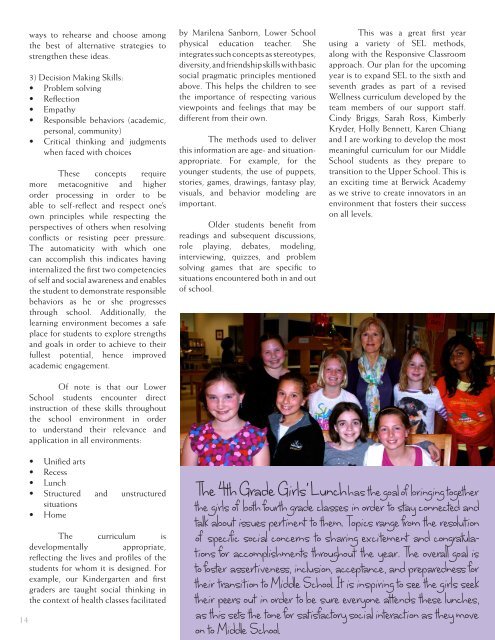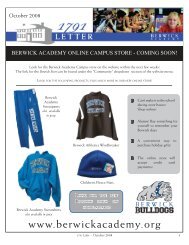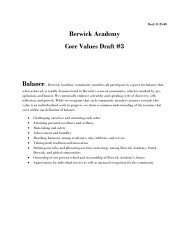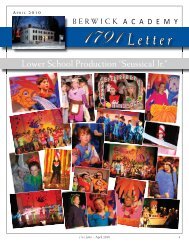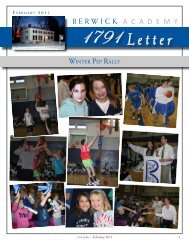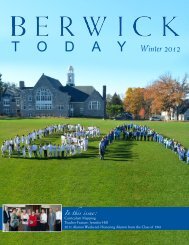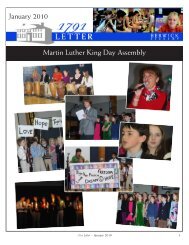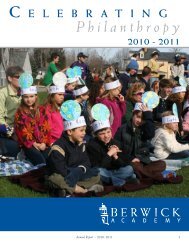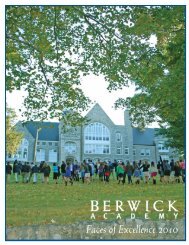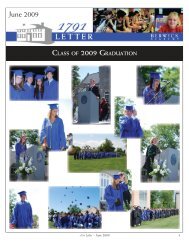You also want an ePaper? Increase the reach of your titles
YUMPU automatically turns print PDFs into web optimized ePapers that Google loves.
14ways to rehearse and choose amongthe best of alternative strategies tostrengthen these ideas.3) Decision Making Skills:• Problem solving• Reflection• Empathy• Responsible behaviors (academic,personal, community)• Critical thinking and judgmentswhen faced with choicesThese concepts requiremore metacognitive and higherorder processing in order to beable to self-reflect and respect one’sown principles while respecting theperspectives of others when resolvingconflicts or resisting peer pressure.The automaticity with which onecan accomplish this indicates havinginternalized the first two competenciesof self and social awareness and enablesthe student to demonstrate responsiblebehaviors as he or she progressesthrough school. Additionally, thelearning environment becomes a safeplace for students to explore strengthsand goals in order to achieve to theirfullest potential, hence improvedacademic engagement.Of note is that our LowerSchool students encounter directinstruction of these skills throughoutthe school environment in orderto understand their relevance andapplication in all environments:• Unified arts• Recess• Lunch• Structured and unstructuredsituations• HomeThe curriculum isdevelopmentally appropriate,reflecting the lives and profiles of thestudents for whom it is designed. Forexample, our Kindergarten and firstgraders are taught social thinking inthe context of health classes facilitatedby Marilena Sanborn, Lower Schoolphysical education teacher. Sheintegrates such concepts as stereotypes,diversity, and friendship skills with basicsocial pragmatic principles mentionedabove. This helps the children to seethe importance of respecting variousviewpoints and feelings that may bedifferent from their own.The methods used to deliverthis information are age- and situationappropriate.For example, for theyounger students, the use of puppets,stories, games, drawings, fantasy play,visuals, and behavior modeling areimportant.Older students benefit fromreadings and subsequent discussions,role playing, debates, modeling,interviewing, quizzes, and problemsolving games that are specific tosituations encountered both in and outof school.This was a great first yearusing a variety of SEL methods,along with the Responsive Classroomapproach. Our plan for the upcomingyear is to expand SEL to the sixth andseventh grades as part of a revisedWellness curriculum developed by theteam members of our support staff.Cindy Briggs, Sarah Ross, KimberlyKryder, Holly Bennett, Karen Chiangand I are working to develop the mostmeaningful curriculum for our MiddleSchool students as they prepare totransition to the Upper School. This isan exciting time at <strong>Berwick</strong> <strong>Academy</strong>as we strive to create innovators in anenvironment that fosters their successon all levels.The 4th Grade Girls’ Lunch has the goal of bringing togetherthe girls of both fourth grade classes in order to stay connected andtalk about issues pertinent to them. Topics range from the resolutionof specific social concerns to sharing excitement and congratulationsfor accomplishments throughout the year. The overall goal isto foster assertiveness, inclusion, acceptance, and preparedness fortheir transition to Middle School. It is inspiring to see the girls seektheir peers out in order to be sure everyone attends these lunches,as this sets the tone for satisfactory social interaction as they moveon to Middle School.Learning to Be Kind“Is anyone going to sign up?”“I hope so.”“Do you think we made it sound fun enough?”“I think so, but teenage girlsare a tough crowd.”This was the conversation MiddleSchool teacher Jennifer Hill and I hadas we eagerly waited to hear whetherwe had participants for the first GIRLS(Girls in Real Life Situations) Group.Our targets were seventh and eighthgrade girls who would sign up for ouractivity period voluntarily instead ofchoosing such things as juggling, Introductionto Chinese, or glee. Wehad some tough competition, but inthe end, we had 10 girls sign up withnothing more than a description thatincluded “talking about all things Girland eating food.” Our plan was tomeet for 25 minutes during the Mondayactivity period for the winter trimesterand to somehow develop cohesionamong a small, self-selected groupof adolescent girls.GIRLS Group came out of theidea that Middle School girls neededa place to talk about what it means tobe a teenage girl and a woman. Theyneeded a place where they could developconfidence and strength to riseabove catty behavior and see eachother as friends instead of enemies.Our dream was to mold these girls intosocial leaders in the Middle School.According to Laura Swayneand her 2008 research on adolescentgirls, there is one factor that stands outas the key to helping reduce relationalaggression, and that is social interest.This includes topics such as empathy,responsibility, cooperation, and communication.If a girl is truly empathetic,she is less likely to be mean out ofspite. If a girl is responsible and knowshow to cooperate in class, she is lesslikely to be disruptive. If a girl knowshow to truly communicate (not justthrough texting), she is more likely toaddress issues with a friend in a directand productive manner. All of thesesocial interest topics are consideredmajor themes of character education.Though GIRLS Group is nota character education course, we knewit was a good platform to teach valuesassociated with strong moral character.The J.C. Watts quote, “Character isdoing the right thing when nobody islooking,” was really what we were tryingto capture. We hoped that thesegirls would realize that it was easier tobe kind than it was to be mean, and associal leaders, this idea would trickledown throughout the school.The first activity that workedto promote kindness was the use ofBoom Boom Cards. These cards haveideas for random acts of kindness specificto teens. “The next time you hearpeople talking badly about someone,don’t be a part of it,” or “For one daydo not call anyone a name, even if it’sby Kim Kryder,Middle and Upper School Counseloryour friend and you are just kidding,”are examples. We let the girls choosewhich act of kindness they wanted toperform, and the next week they reportedback to the group. A couplethings were surprising. First, many ofthe girls actually did some risky acts ofkindness, such as writing a note to anacquaintance, telling him or her howhe or she is special and putting it in hisor her locker. And second, they enjoyeddoing it. So we did it the nextweek too, and soon the girls were doingsome things on their own withouta card.Beyond acts of kindness, wealso talked about how girls are viewedby the world and how girls view themselves.This was an activity to bringthe girls together and realize they areall different, but with many commonvalues. A simple activity of filling inthe blanks gave us some great insight.How would you complete these phrases?Girls are…Girls can be…Girls should be…I am…I can be…I should be…Do you fall back on stereotypes,or do you find the positive15


